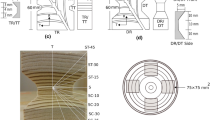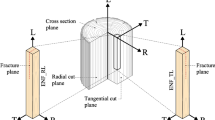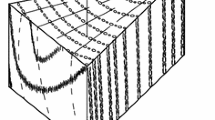Abstract
In this study, the stress distribution and stress concentration factor (SCF) of a generic notched wood piece and ASTM D 143:14 notched shear block specimen were analysed. A 2D plane stress finite element model with linear elastic behaviour was assumed for the bulk material and a predefined potential crack path and cohesive behaviour of the crack surfaces were considered. Wood was considered an orthotropic material with transversal isotropy. In the notched wood pieces, the shear stress distribution along the shear plane and the SCF when varying the ratio l/t (length of the heel/depth of the notch) was obtained. The shear stress distribution is not uniform in any situation, approaching a slightly triangular shape. The shear stress concentration increases when l/t is greater and for l/t > 8 failure occurs due to crack progression. The SCF can be brought fairly close to the natural logarithm of l/t. In the ASTM D 143:14 notched shear block specimen, shear stress distribution only remains a constant value in the central part of the shear plane, while the SCF is greater than 2.










Similar content being viewed by others
References
Aira JR (2013) Experimental and FEM analysis of the stress state of halved and tabled traditional timber scarf joint. Doctoral Thesis. Department of Building and Rural Roads. Technical University of Madrid. Spain
Aira JR, Arriaga F, Íñiguez-González G, Guaita M, Esteban M (2012) Analysis of the stress state of a halved and tabled traditional timber scarf joint with the finite element method. WCTE 2012. World Conference on Timber Engineering. Auckland, New Zealand
ASTM D143:14 Standard test methods for small clear specimens of timber. ASTM International, West Conshohocken, PA
Barenblatt GI (1962) The mathematical theory of equilibrium cracks in brittle fracture. Adv Appl Mech 7:55–129
Boström L (1992) Method for determination of the softening behaviour of wood and the applicability of a nonlinear fracture mechanics model. Doctoral Thesis. Report TVBM- 1012. Lund. Sweden
Burgert I, Eckstein D (2001) The tensile strength of isolated wood rays of beech (Fagus sylvatica L.) and its significance for the biomechanics of living trees. Trees 15:168–170
Coker EG, Coleman GP (1935) Photo-elastic investigation of shear tests of timber. Selected Engineering Pap. No. 174. The Institution of Civil Engineers, London, England
Cramer SM, Goodman JR, Bodig J, Smith FW (1984) Failure modeling of wood structural members. Structural Res. No. 51. Civil Engineering Dept. Colorado State Univ
Dahl KB, Malo KA (2009a) Linear elastic properties of spruce softwood. Wood Sci Technol 43:499–525
Dahl KB, Malo KA (2009b) Nonlinear shear properties of spruce softwood: experimental results. Wood Sci Technol 43:539–558
Dahl KB, Malo KA (2009c) Nonlinear shear properties of spruce softwood: numerical analyses of experimental results. Composit Sci Technol 69:2144–2151
Danielsson H, Gustafsson PJ (2013) A three dimensional plasticity model for perpendicular to grain cohesive fracture in wood. Eng Fract Mech 98:137–152
De Moura MFSF, Oliveira JMQ, Morais JJL, Dourado N (2011) Mixed mode (I + II) fracture characterization of wood bonded joints. Constructions and Building Materials 1956–1962
Dugdale DS (1960) Yielding of steel sheets containing slits. J Mech Phys Solids 8:100–104
Fortino S, Zagari G, Mendicino AL, Dill-Langer G (2012) A simple approach for FEM simulation of Mode I cohesive crack growth in glued laminated timber under short-term loading. Rakenteiden Mekaniikka (J Struct Mech) 45(1):1–20
Gustafsson PJ, Enquist B (1988) Wooden beam strength at right angle notch (Träbalks Hållfasthet vid rätvinklig urtagning). Report TVSM-7042. Division of Structural Mechanics, Lund University
Hillerborg A, Modée M, Peterson PE (1976) Analysis of crack formation and crack growth in concrete by means of fracture mechanics and finite elements. Cem Concr Res 6:773–782
Majano-Majano A, Hughes M, Fernández-Cabo JL (2012) The fracture toughness and properties of thermally modified beech and ash at different moisture contents. Wood Sci Technol 46:5–21
Moses DM, Prion HGL (2002) Anisotropic plasticity and the notched wood shear block. For Prod J 52(6):43–54
Radcliffe BM, Suddarth SK (1955) The notched beam shear test for wood. For Prod J 5(2):131–135
Reiterer A, Burgert I, Sinn G, Tschegg S (2002a) The radial reinforcement of the wood structure and its implication on mechanical and fracture mechanical properties—a comparison between two tree species. J Mater Sci 37:935–940
Reiterer A, Sinn G, Stanzl-Tschegg SE (2002b) Fracture characteristics of different wood species under mode I loading perpendicular to the grain. Mater Sci Eng A332:29–36
Smith I (1983) Coefficient of friction values applicable to contact surfaces between mild steel connectors such us bolts and dry European white wood. J Inst Wood Sci 9(5):229–234
Smith I, Landis E, Gong M (2003) Fracture and Fatigue in Wood. Wiley Editorial, England 234p
Stefansson F (2001) Fracture Analysis of Orthotropic Beams. Lund University, Licenciate Dissertation
Vasic S, Smith I (2002) Bridging crack model for fracture of spruce. Eng Fract Mech 69:745–760
Acknowledgments
This research was finished during a Short Term Scientific Mission by Mr. José-Ramon Aira at the University of Mons. All of the authors would like to thank the European Organisation for Cooperation in Science and Technology, and in particular the COST Action FP1101 for the “Assessment, Reinforcement and Monitoring of Timber Structures” for their financial support.
Author information
Authors and Affiliations
Corresponding author
Rights and permissions
About this article
Cite this article
Aira, J.R., Descamps, T., Van Parys, L. et al. Study of stress distribution and stress concentration factor in notched wood pieces with cohesive surfaces. Eur. J. Wood Prod. 73, 325–334 (2015). https://doi.org/10.1007/s00107-015-0891-3
Received:
Published:
Issue Date:
DOI: https://doi.org/10.1007/s00107-015-0891-3




